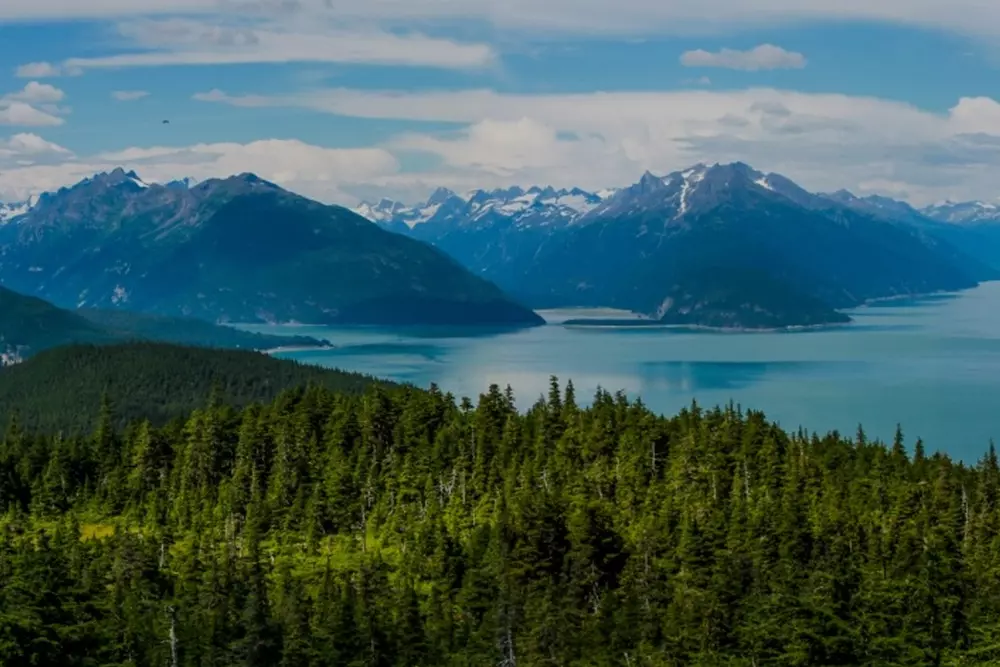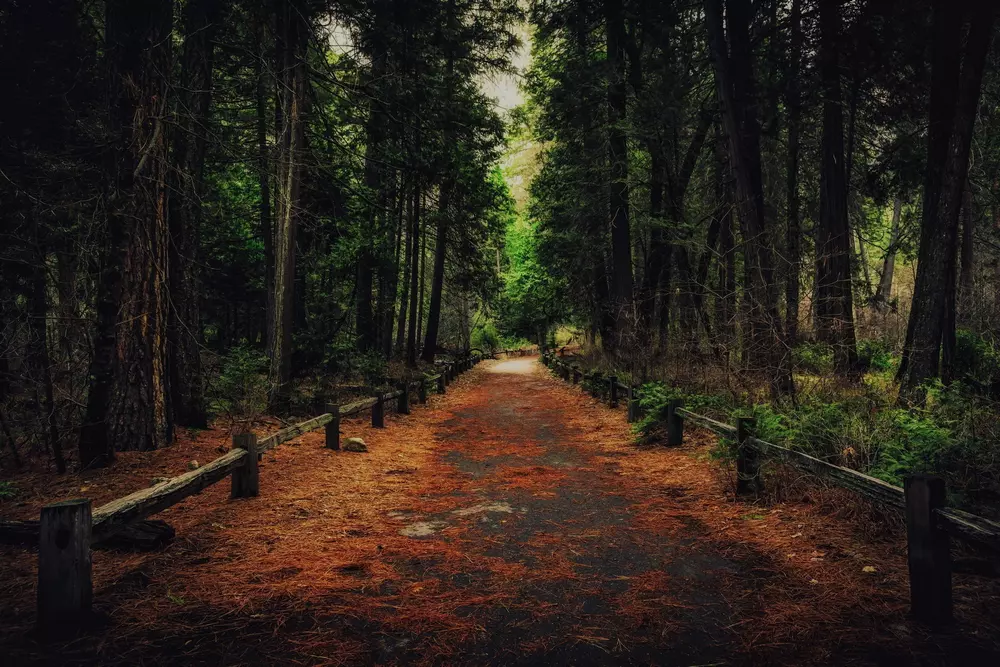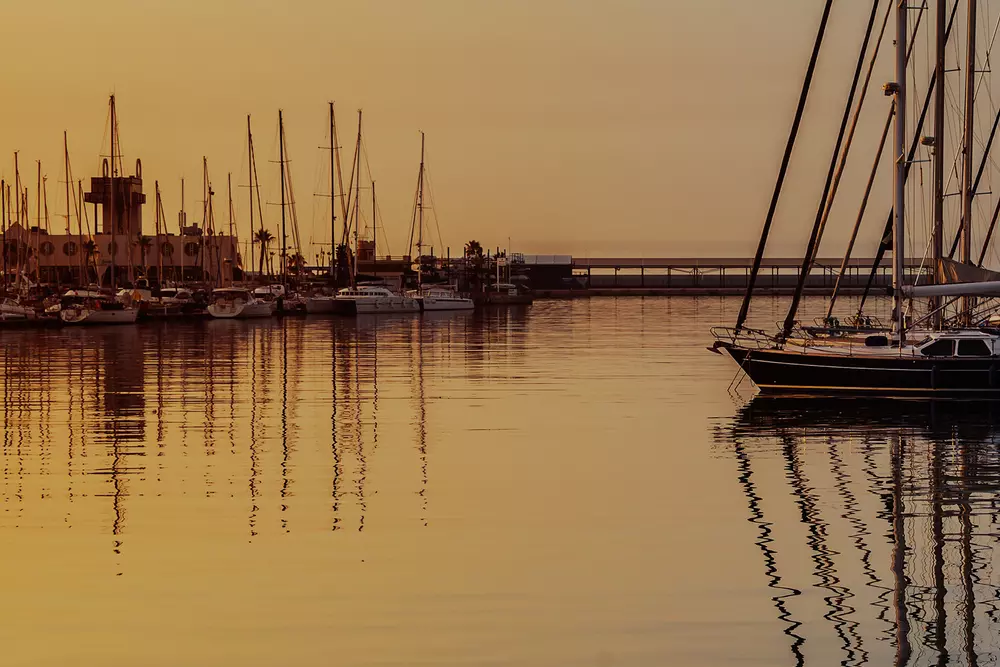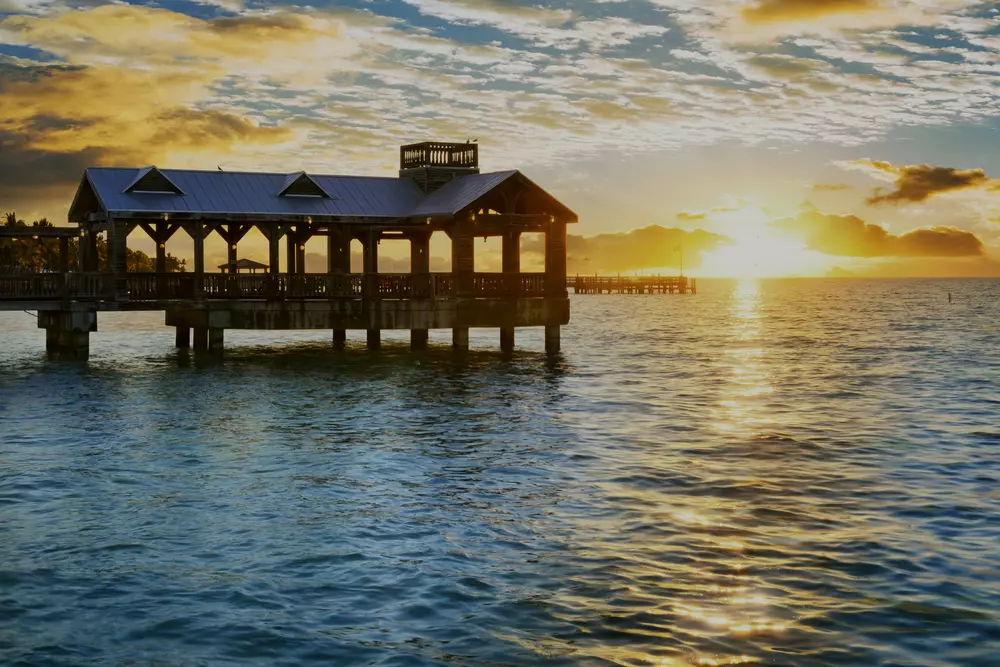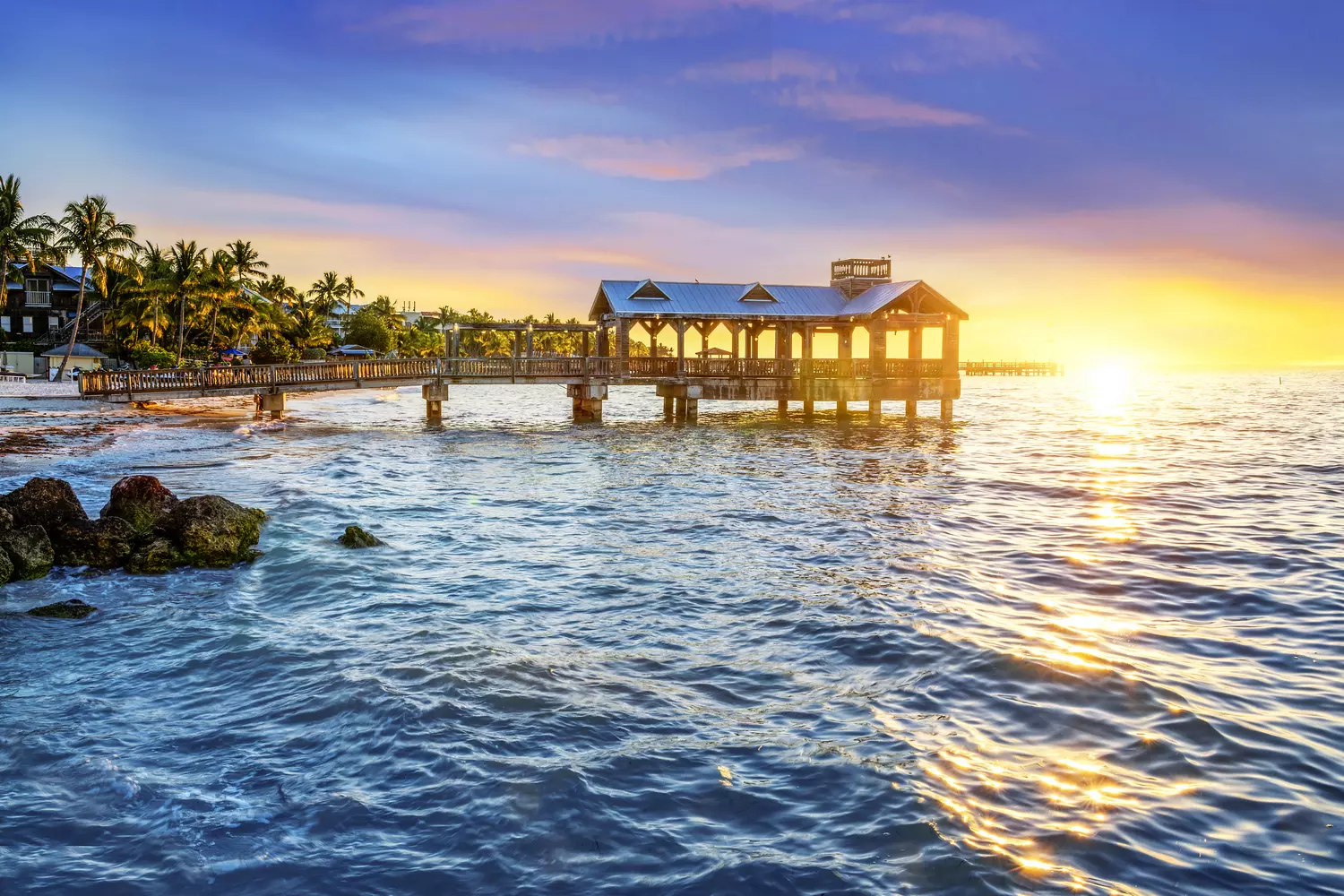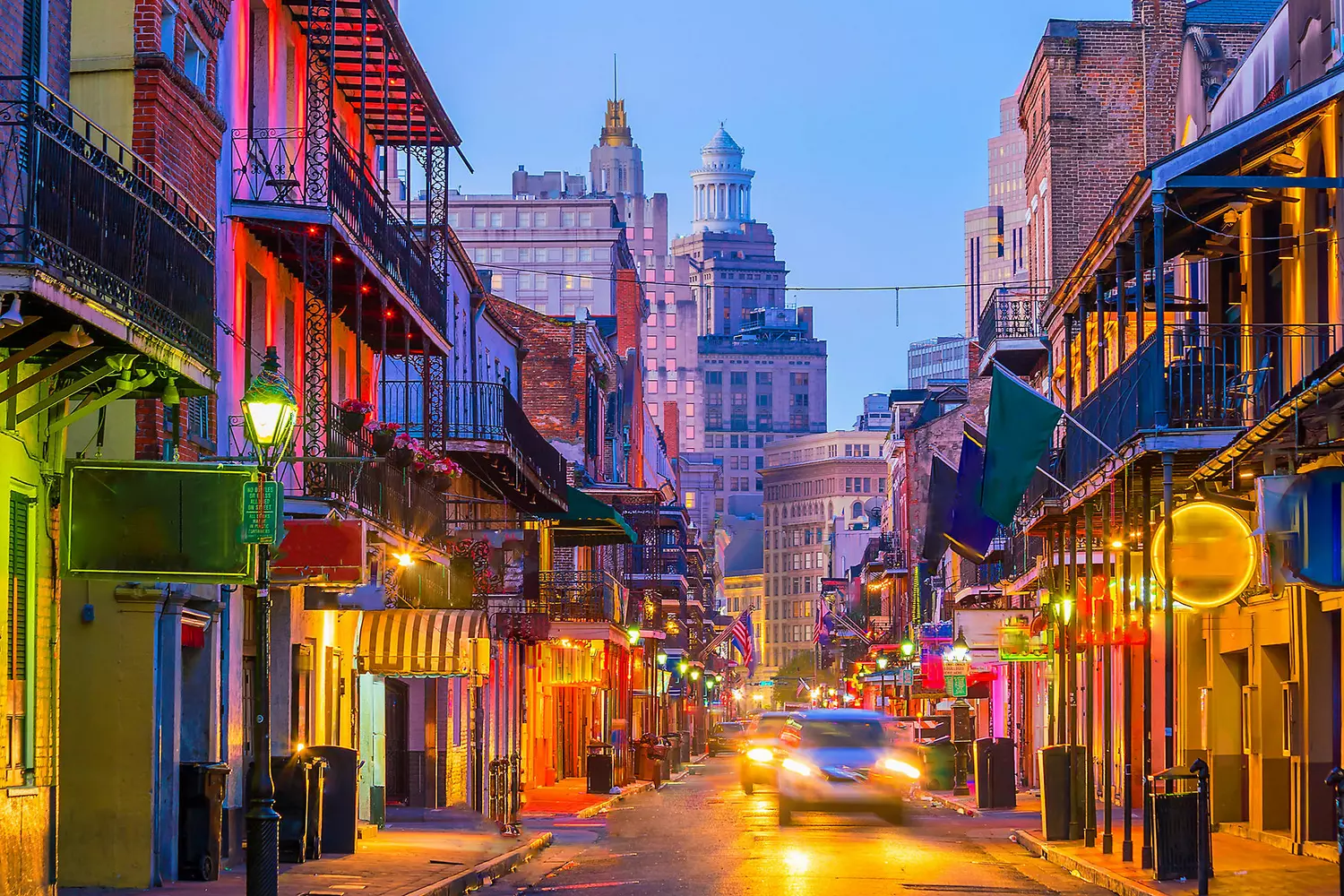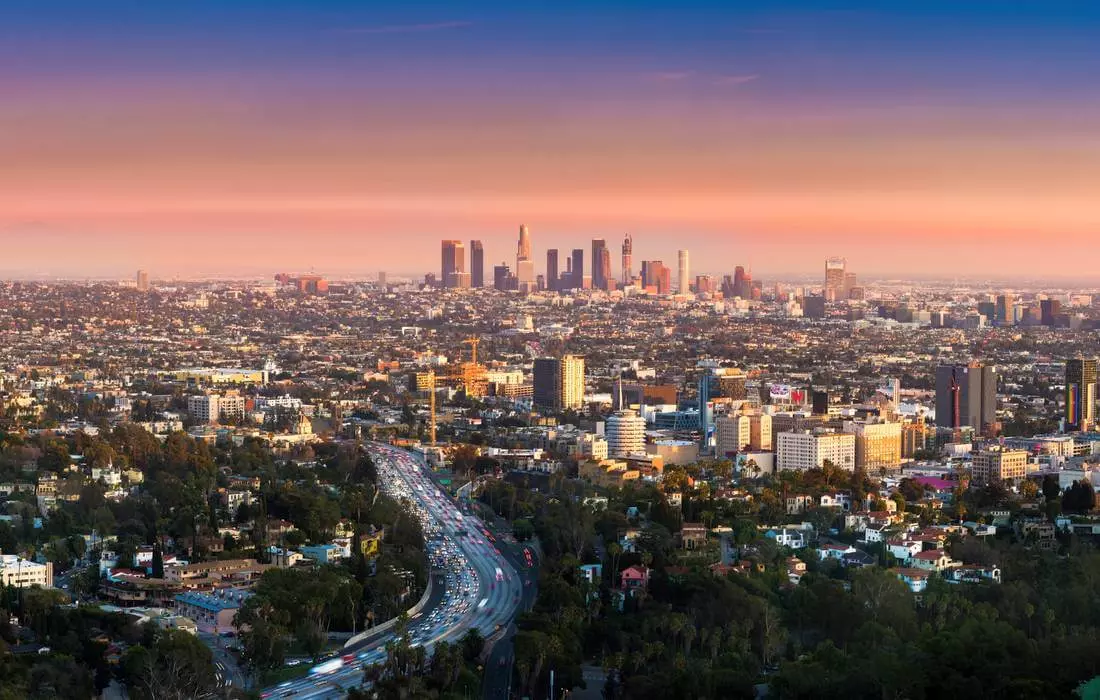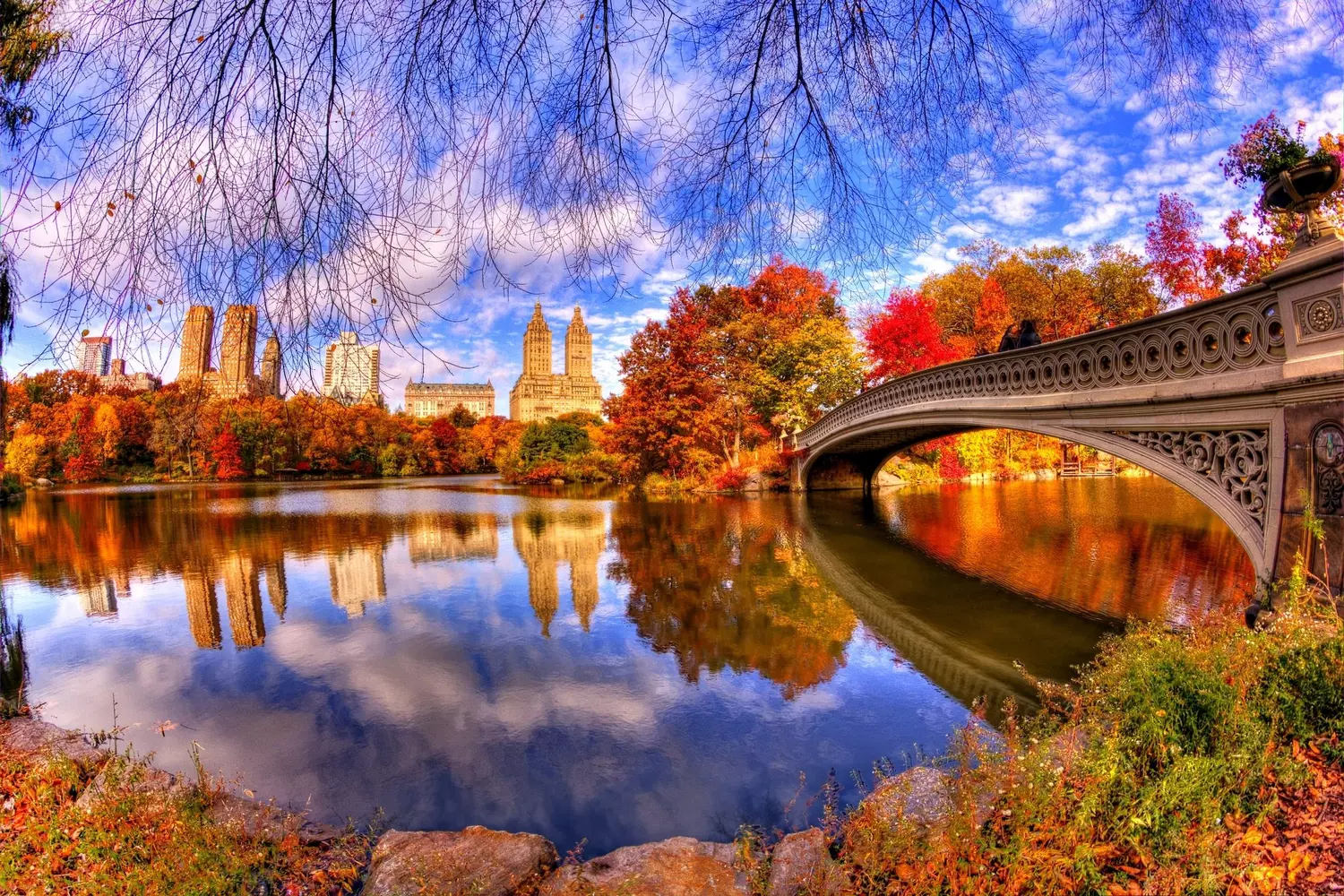Yellowstone National Park is not just a green spot in the middle of the American West. It is a living, breathing part of the planet where the earth literally bubbles and boils beneath your feet. Everything here is unusual: the air smells of sulfur, the landscapes change with every mile, and the sky reflects in the multicolored lakes and steam clouds.
This park made history as the world’s first national park, established in 1872 to protect what did not fit into the usual categories — geysers, thermal springs, boiling mud pots, and wild, unexplored expanses. The idea of preserving nature not for exploitation but for its beauty and uniqueness seemed almost revolutionary at the time. But it was Yellowstone that started an era in which humanity first realized that such places must be protected.
Every year Yellowstone welcomes over 4 million tourists. People come not only to take selfies with geysers but to experience something real. To hear the roar of waterfalls, feel the heat of the earth beneath wooden walkways, see a bison at dawn, or meet the gaze of a wolf at sunset.
There are more than 10,000 geothermal features here — nearly half of all in the world. Beneath the park lies one of the most powerful supervolcanoes on the planet, and every spring, every crack in the ground is a reminder that we stand on the edge of a powerful natural force.
But Yellowstone is not just geysers. It also has deep canyons, high mountain lakes, limestone terraces that look tropical, and valleys where herds of bison roam against snowy mountains. It is one of the few places where you can see everything in one day — from glacial plateaus to boiling craters.
If you are looking for a place to relax, be inspired, and remember how diverse our world can be — Yellowstone tops the list. In this guide, we will tell you about the most interesting places in the park that you must not miss to fully feel its magic.
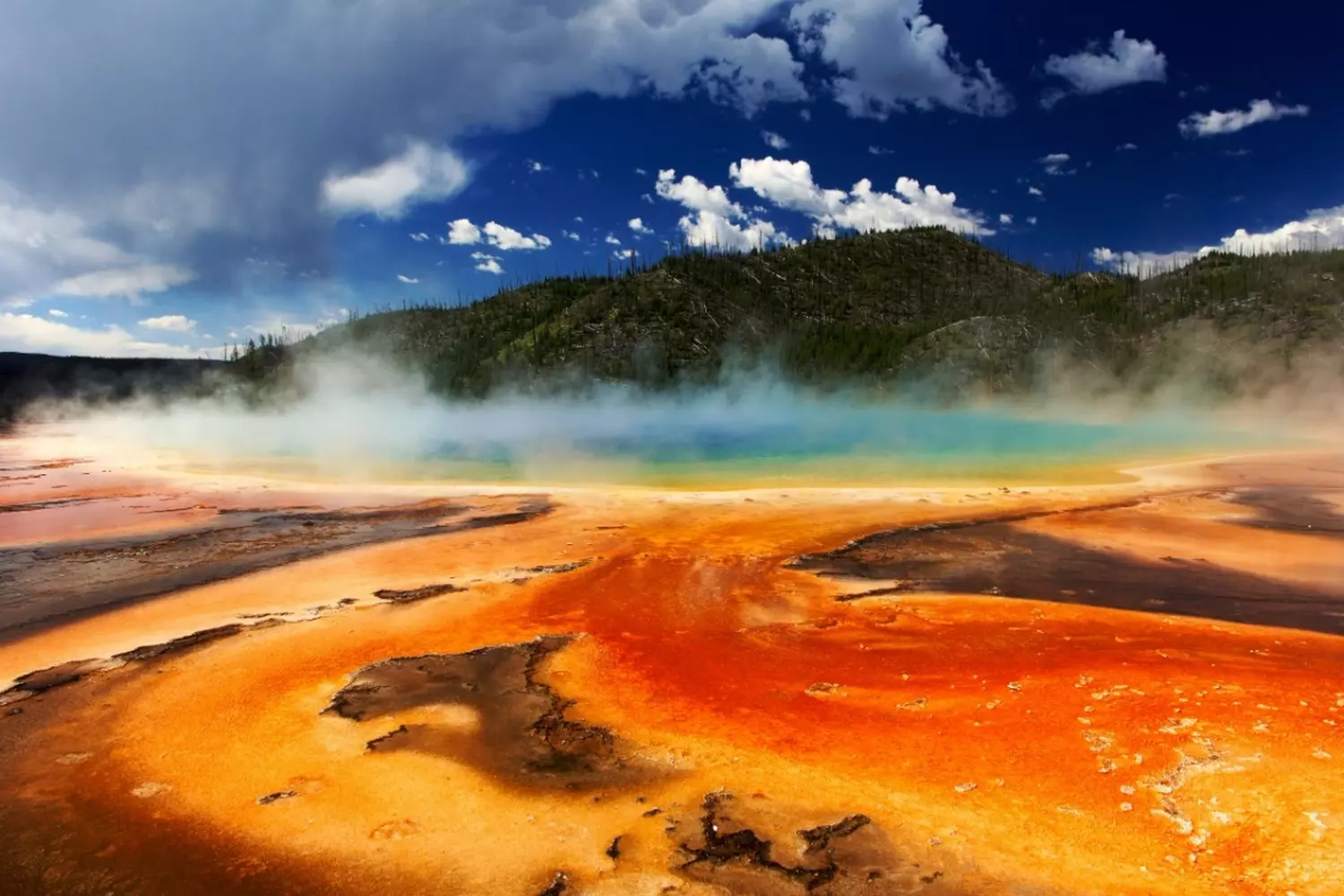
Yellowstone experiences between 1,000 and 3,000 earthquakes each year — most are too small to feel, but they serve as a reminder: the Earth here is very much alive.
The Heart of the Earth: What Lies Beneath Yellowstone’s Surface
Yellowstone is not just a national park. It is a land where the Earth speaks to humans through steam, boiling water, and slowly shifting tectonic plates. Its area exceeds 9,000 square kilometers, which is almost the size of all of Cyprus or twice the size of Luxembourg. It spans across three American states: Wyoming, Montana, and Idaho — yet it does not fully belong to any of them. The geography here itself is a symbol of scale.
- The park was established in 1872 — becoming the first national park not only in the USA but in the entire world. This was an unprecedented decision: to declare wilderness as an object to be preserved for future generations. Back then, no one talked about climate, biodiversity, or ecotourism. It was an act of admiration — for pure, pristine nature, which humanity decided for the first time not to exploit but to protect.
- The main mystery and uniqueness of Yellowstone lie beneath its surface. Beneath all this beauty — from coniferous forests to rainbow-colored springs — hides a gigantic supervolcano caldera. This underground giant, spanning hundreds of kilometers, is dormant but not asleep. Scientists regularly record underground tremors, rising temperatures, and ground swelling. Yellowstone is an active geological organism.
- While the volcano rests, Yellowstone lives its vibrant life on the surface. Here you can see hundreds of geysers, thousands of thermal springs, mud volcanoes, misty valleys, and alpine meadows. Crystal-clear mountain lakes reflect evergreen coniferous forests, over which a bald eagle — the symbol of America — may easily fly. The riot of colors, scents, and textures — everything here reminds you that nature is an artist with a wild imagination.
Yellowstone is not just a park. It is a snapshot of the Earth in motion, a theater of natural forces usually hidden from sight. Here, you can literally feel the planet breathe — and realize how alive it truly is.
In the event of an eruption, the supervolcano could eject enough ash and gas into the atmosphere to drop global temperatures by several degrees and alter the climate for decades. This event would be comparable to a nuclear winter. The good news: the likelihood of such an eruption in the next century is extremely low.
Yellowstone cannot be taken in with a single glance or in one day — it is like a kaleidoscope of natural wonders. Every turn of the road leads to a new landscape: a bubbling spring, a turquoise lake, a rushing waterfall, or a valley where wild bison graze. To avoid getting lost in this diversity, we have gathered ten of the most impressive places that every traveler should include in their itinerary.
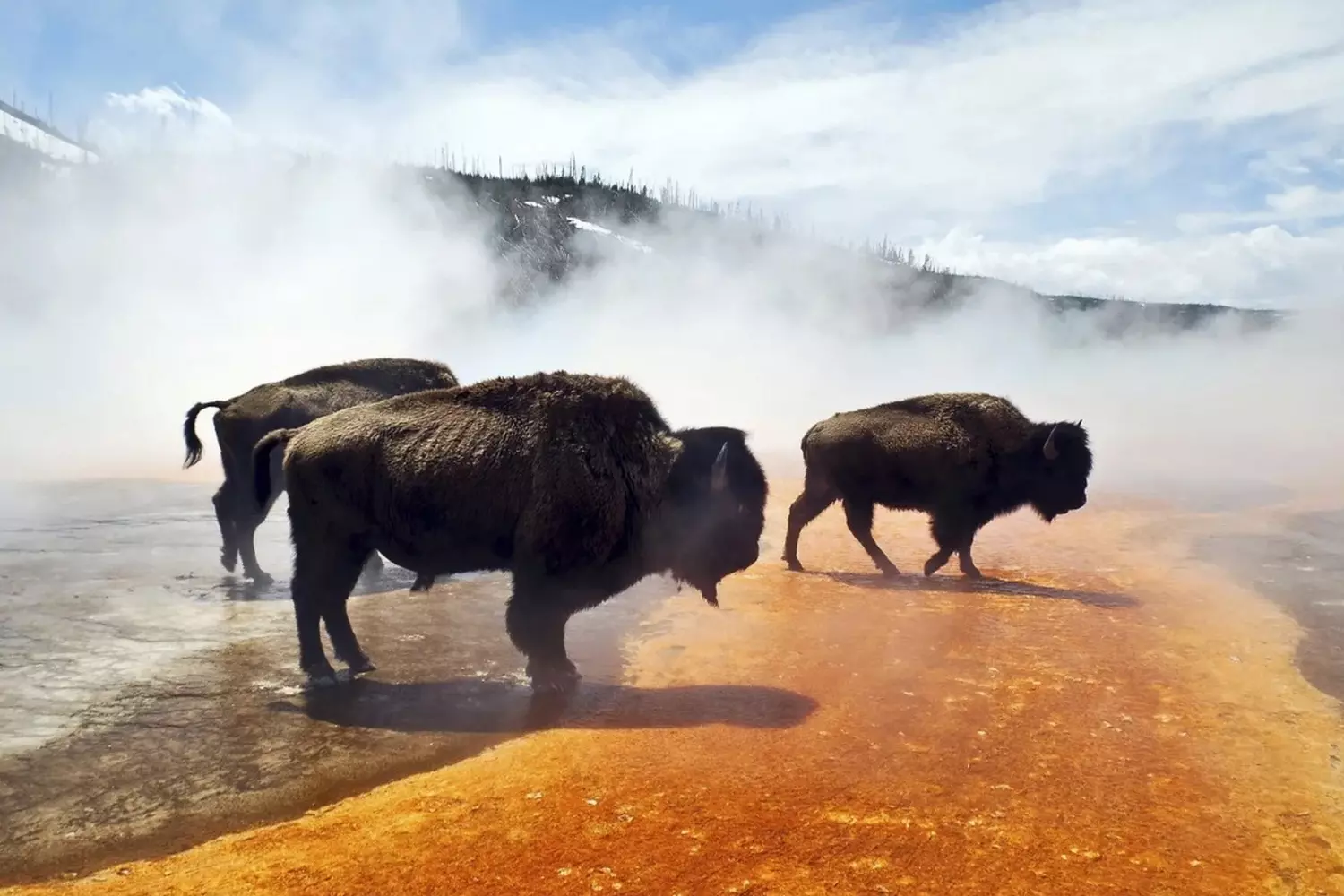
Old Faithful: The Geyser That Never Lets You Down
If Yellowstone had its own flag, it would definitely feature Old Faithful Geyser — the park’s symbol and one of the most recognizable natural phenomena in the world. This natural wonder reliably reminds people that the Earth is alive, powerful, and anything but boring.
Old Faithful is its English name, meaning “Old Faithful” or “Old Reliable.” The name was given back in 1870 by members of the Washburn expedition, and since then the geyser has perfectly lived up to its name. It never lets you down: every 60–110 minutes (on average every 90 minutes), it shoots a giant plume of boiling water up to 55 meters high, sometimes even higher.
- 01. Why this place is a must-see in Yellowstone
- Almost guaranteed show
At the visitor center near the geyser, you can find out the exact time of the next eruption — a rare luxury in the natural world. - Top-notch infrastructure
There are wide viewing platforms, convenient trails, the Old Faithful Inn hotel (one of the oldest in US national parks), souvenir shops, and cafes — everything for a comfortable visit. - The surroundings are just as impressive
Nearby lies a whole geothermal field with dozens of other springs: Castle Geyser, Beehive Geyser, Riverside Geyser, and picturesque boiling pools with turquoise water. You can spend an entire day strolling wooden boardwalks between steaming craters. - A legend proven by time
For almost 150 years of observation, Old Faithful has never disappeared or gone silent for long. It’s an exceptional case of stability among geysers, which often become unpredictable or cease activity altogether.
- 02. Best time to visit...
- Early morning or near sunset
Fewer people, softer light, and a magical spectacle. - Winter
Imagine white snow, silence, and suddenly — the geyser erupts with a cloud of steam and water. It’s almost like a movie, but real.
Old Faithful is not just an attraction. It’s a geyser that works like clockwork, putting on a show worthy of applause every time. Even if you’ve seen it once — you’ll want to come back again.
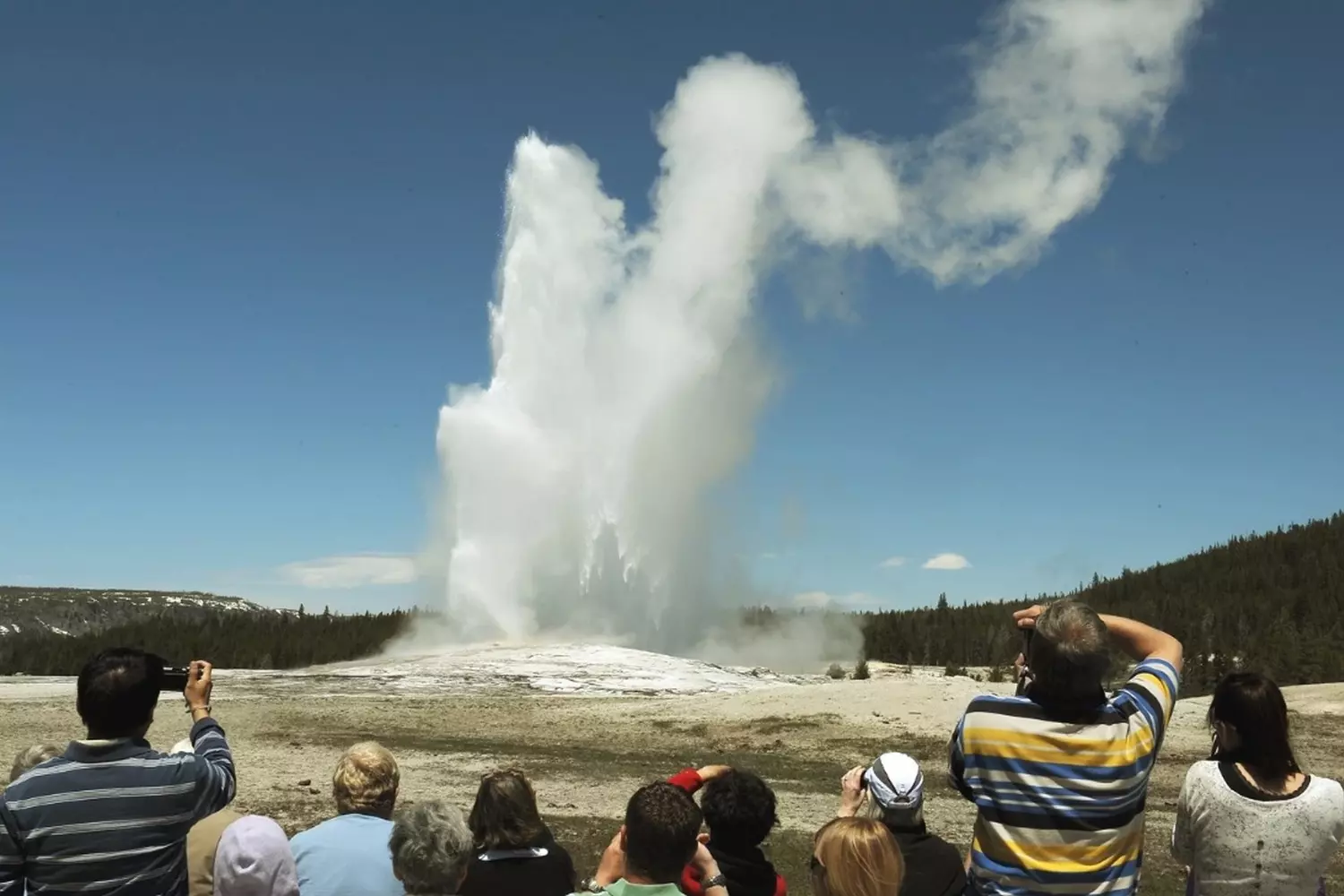
Grand Prismatic Spring: A Hot Lake of All the Colors of the Rainbow
If nature could paint with watercolors, it would do so here. The Grand Prismatic Spring is a living canvas, blending vivid shades of blue, green, yellow, orange, and red. Each hue isn’t random but a result of complex biochemistry happening right beneath your feet.
This is the largest hot spring in the USA and the third largest in the world. Its diameter exceeds 110 meters, with a depth of about 50 meters. The center of the spring is dark blue and nearly transparent, while moving outward, the water takes on yellow-orange and red tones. This rainbow effect arises from thermophilic bacteria living in waters of different temperatures, each colony coloring its surroundings in its own shade.
- 01. Why this place is worth seeing with your own eyes
- An absolutely unique natural phenomenon
The colors of the Grand Prismatic Spring are unmatched anywhere else on the planet. Each season they slightly shift depending on water temperature and bacterial activity. - The best photo spot is not right at the edge
To appreciate the full palette, climb the Fairy Falls Trail — a viewing path leading to a hill with panoramic views from above. This is where the iconic photos that decorate guides and desktop wallpapers are taken. - It’s a living formation
The terraces around the spring grow and change, water constantly evaporates, and steam rises almost continuously — everything breathes, hisses, and glimmers in the sunlight. - Swimming is forbidden and not recommended
The water temperature in the center exceeds 70°C, and in some spots it’s even hotter. Moreover, the spring’s ecosystem is extremely fragile: even one foreign object falling into the water can disrupt the microbial balance for years.
- 02. Best times to visit
- Summer — the most spectacular time
On clear days, the contrast between the blue sky, the spring’s colors, and the surrounding greenery is especially striking. - Autumn — for those seeking solitude
Fewer visitors, cool air, and gentle steam give the spring a mystical atmosphere. - Early morning — a chance to see everything without crowds
Additionally, steam rises especially thick and beautiful at this time.
The Grand Prismatic Spring is like a stained glass window created by nature itself. It doesn’t shout, erupt, or roar, but captivates silently. It’s a place where you can stand for hours, quietly admiring its beauty.
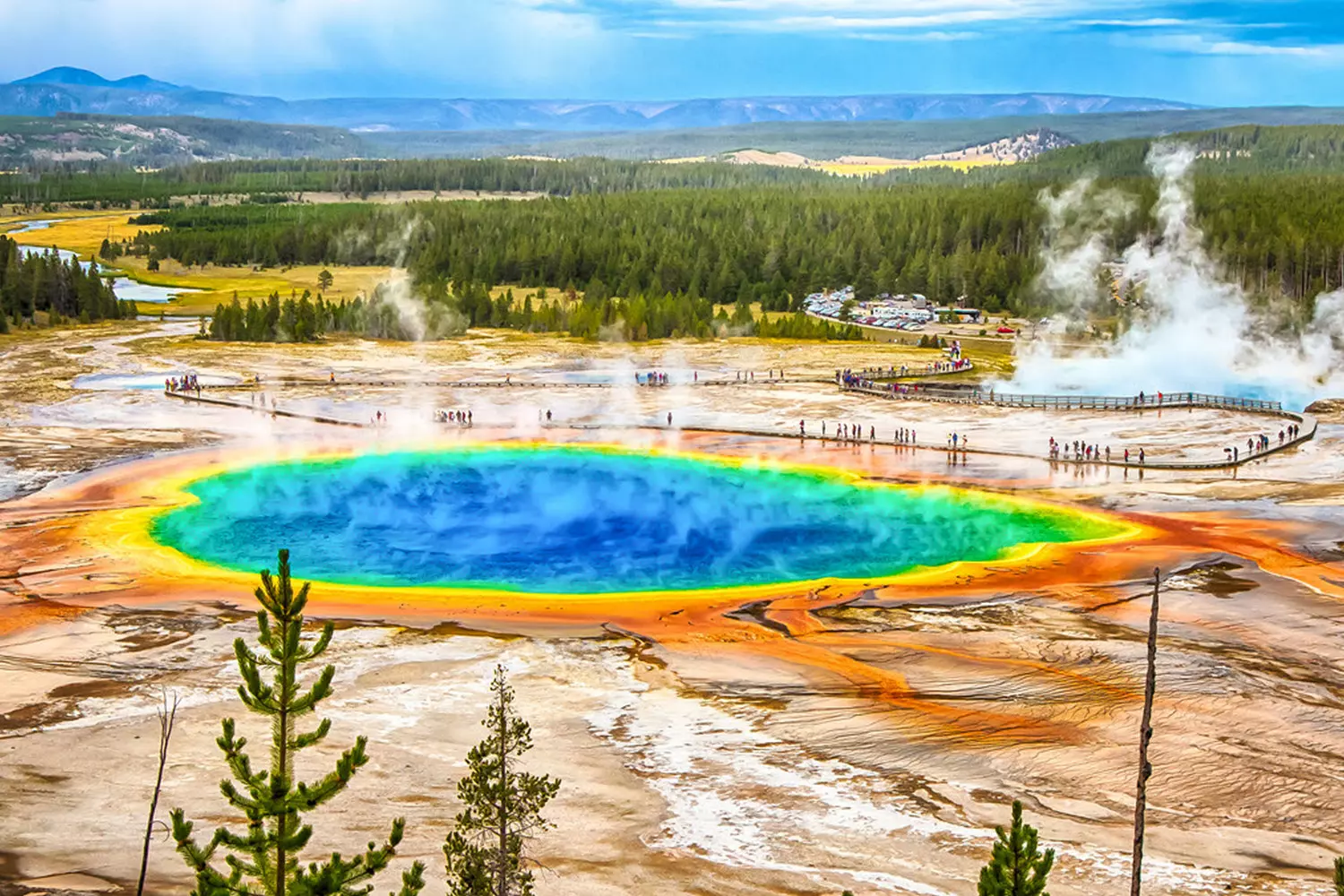
Yellowstone Canyon — The Northern Brother of the Grand Canyon
If the Grand Canyon is like a powerful chord in nature’s symphony, then the Yellowstone Canyon is its picturesque aria. Smaller in size but no less emotionally stirring, this canyon stretches for 32 kilometers and plunges about 365 meters deep, as if carved not by time but by an artist’s brush. It’s no surprise that one of its most popular viewpoints is called Artist Point — from here unfolds a landscape that has inspired painters and photographers for centuries.
The main star of the canyon is the Lower Falls. This waterfall drops water from nearly 100 meters, creating clouds of mist and rainbows on sunny days. Its roar is like the pulse of the earth itself, and the energy with which it crashes down takes your breath away.
But Yellowstone Canyon is not just about water and rock. It’s also a haven for wildlife lovers. On the steep slopes, you can spot nests of bald eagles, peregrine falcons, and even vultures. The silence here is enveloping, and the air is crystal clear. Sometimes, in the shade of the pines, you might catch a glimpse of a deer or a bear running along the cliff edge.
Don’t forget to stop at Lookout Point — here, on the edge of the cliff, you feel the grandeur of nature most keenly. Early in the morning, you can watch the first rays of the sun slowly paint the rock walls in pink, golden, and copper hues. Probably one of the most poetic spots in Yellowstone. Traveler’s tips:
- Visit Artist Point at dawn — fewer tourists, maximum magic.
- Bring binoculars — eagles and falcons often hover over the canyon skies.
- In summer, take water and a hat — the trail can be hot and exposed.
One last fact: The canyon was formed after the Ice Age, when meltwaters began eroding volcanic rocks. That’s why the rocks display such unusual colors — from bright yellow to deep crimson. By the way, this is where the name Yellowstone comes from.
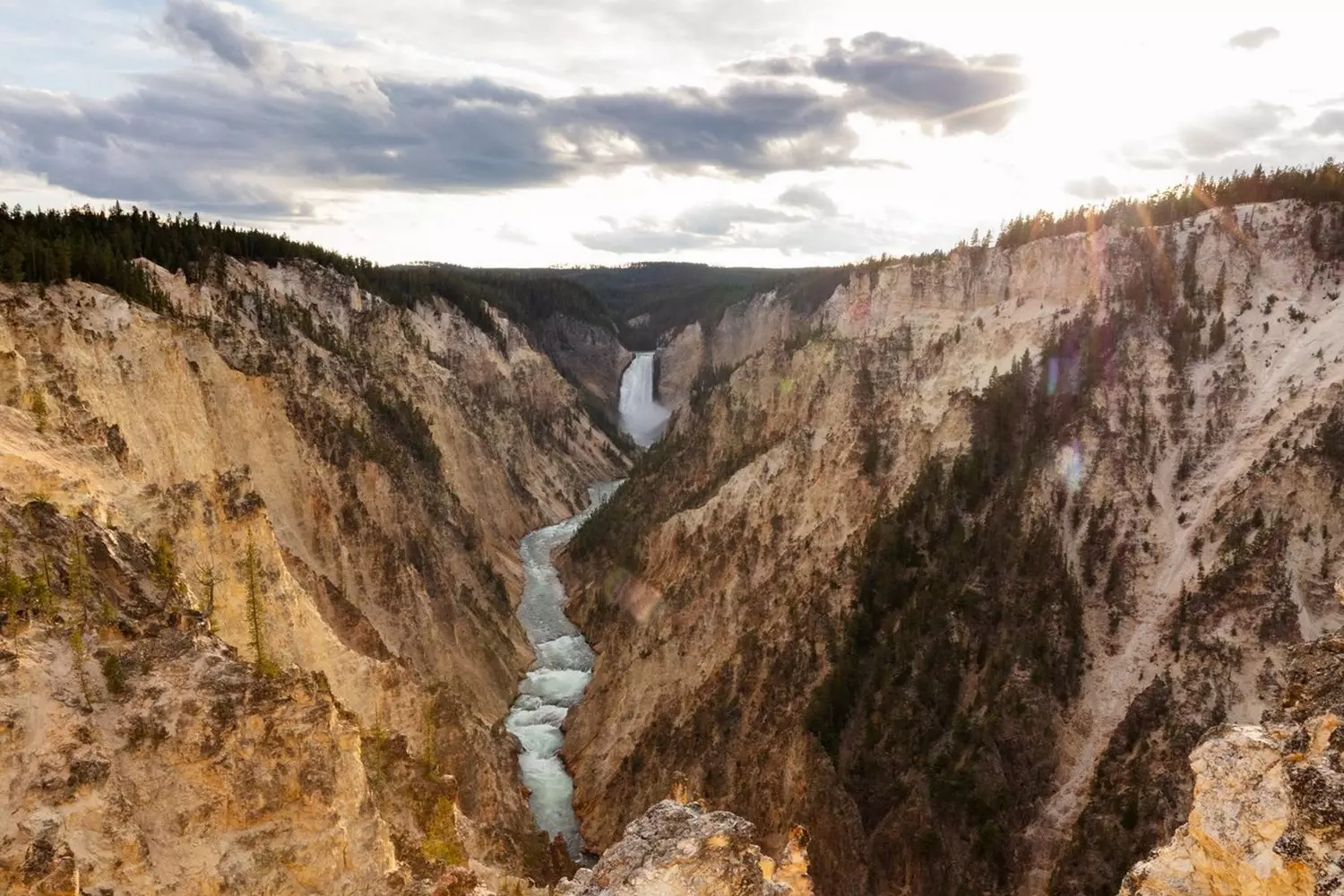
Yellowstone Lake — The Watery Heart of the National Park
Among the roaring geysers, rocky canyons, and dense coniferous forests of Yellowstone National Park hides one of its most mesmerizing natural wonders — Yellowstone Lake. It is the largest high-elevation lake in North America, situated at an altitude of 2,357 meters above sea level and spanning more than 350 square kilometers. Visually, it resembles a mirror reflecting the sky, clouds, and the spirit of pristine America.
- 01. Depth worthy of respect
Although the lake looks peaceful and even lazy from the shore, beneath its surface lies an entire underwater world. The average depth is about 42 meters, with a maximum depth reaching up to 120 meters. Beneath the lake bed, the volcanic caldera still “breathes” actively, creating underwater geysers, hot springs, and fumaroles — an extremely rare phenomenon for freshwater bodies. - 02. Winter ice kingdom, summer fishing paradise
From December to May, the lake is covered with a thick layer of ice. This spectacle alone is worth the trip — especially in March, when the ice begins to crack, creating an atmosphere reminiscent of a distant Arctic land. In summer, the lake transforms: its shores become ideal spots for relaxation, kayaking, camping, and, of course, fishing. The lake’s waters are home to the Yellowstone cutthroat trout — an endemic species that attracts not only tourists but also grizzly bears. - 03. Best places to enjoy the view
One of the best spots to observe the lake is near the Fishing Bridge. From here, you get a captivating view of the endless water expanses and mountains on the horizon. For solitude and picnics, West Thumb — a bay at the southern tip of the lake — is perfect. Here you can wander among hot springs and climb observation hills. It’s also a convenient starting point for heading towards the southern exit of the park or embarking on a kayak safari.
Interesting fact: The underwater thermal formations of the lake are still being studied by scientists. Some sources on the bottom heat the water up to 130°C, but due to the pressure, it does not boil — a unique natural paradox.

Mammoth Terraces: The Petrified Waves of Time
If you have ever dreamed of stepping onto another planet — welcome to Mammoth Hot Springs. This area of Yellowstone National Park is arguably one of the most surreal places in the entire USA. Here, nature literally sculpts masterpieces from time and minerals. The multilayered, snow-white terraces resemble frozen waves, as if crafted not by water, but by drops of marble.
- 01. A scientific wonder of nature
The Mammoth Terraces formed thanks to hot springs rising from deep within the Earth’s crust. As the water passes through limestone rocks, it becomes saturated with calcium and, upon reaching the surface, cools down and deposits minerals. The result is a landscape that looks like icy castles, snowy craters, or petrified waterfalls. - 02. The complexity and beauty of the terraces
The terraces are divided into upper and lower sections. The lower ones are closer to the road and more accessible, while the upper ones require a walk along wooden boardwalks — but it is there that truly otherworldly views open up. Some terraces are brightly colored in shades of ochre, pink, and even green — thanks to microscopic thermophiles living in the hot water. - 03. The perfect time to visit
The best photos are taken early in the morning or at sunset, when the warm light highlights the intricate relief and mist rises above the terraces. At this time, it feels as if you are not on Earth, but on the surface of ancient Mars. - 04. What else is nearby
Nearby is the historic Fort Yellowstone — a former military post turned cultural center and the starting point for park research in the early 20th century. A walk around the fort will complement your experience of the terraces and immerse you in the rich history of Yellowstone’s exploration.
This place is not just a landscape. It’s a geology lesson in real time. The Mammoth Terraces prove that nature is the best artist, sculptor, and architect all at once.
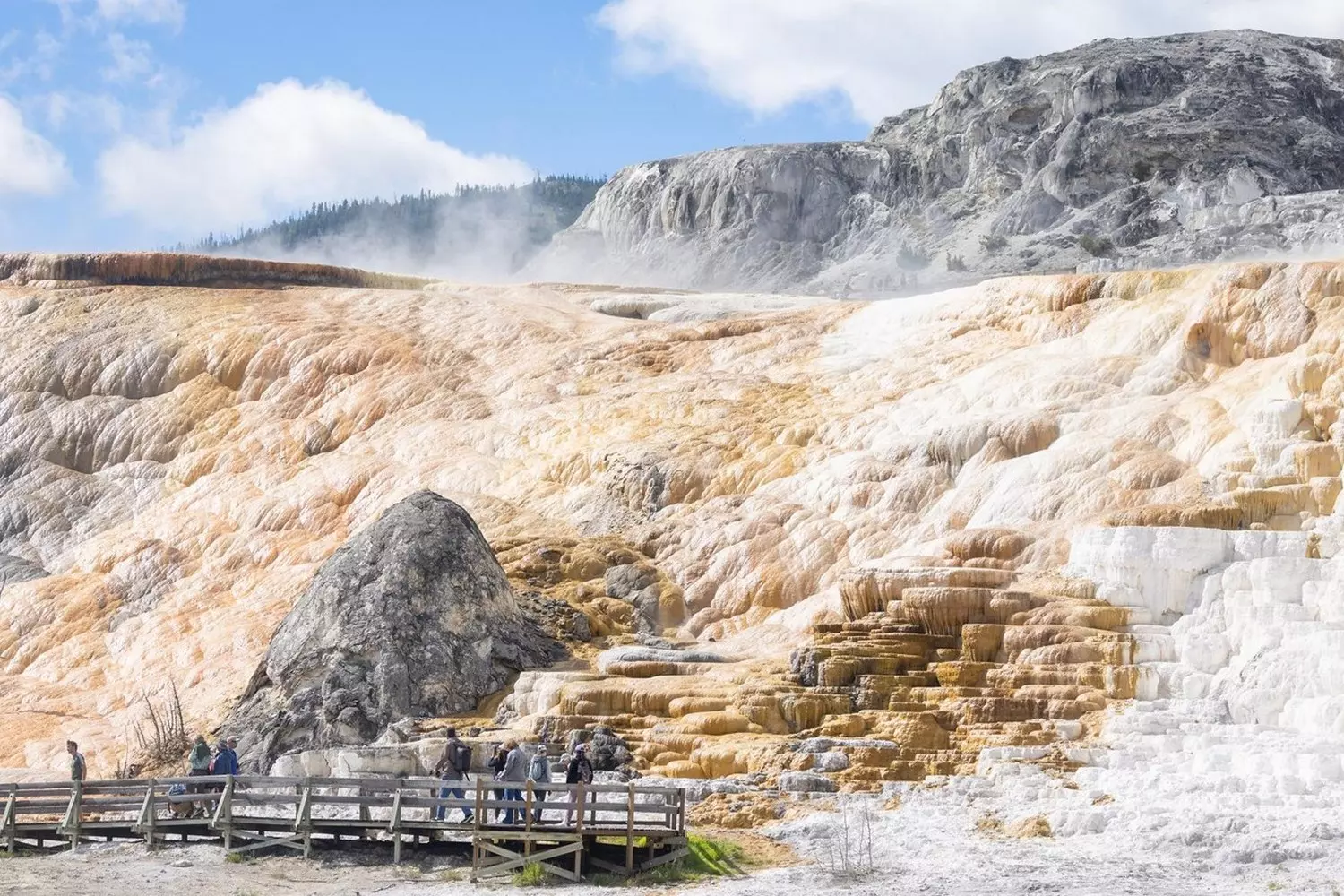
Lamar Valley — The Serengeti of North America: Yellowstone’s Wildlife Kingdom
If you dream of seeing wild animals in their natural habitat, Lamar Valley is the place to go in Yellowstone. This wide valley, covered with grass and bordered by hills, is often called the "Serengeti of North America" — and this nickname is well deserved. Here lies one of the park's richest and most diverse ecosystems, where you can encounter wildlife that even experienced naturalists long to see.
- 01. Who lives in Lamar Valley?
- Bison
These majestic giants are true symbols of the American prairies. In Lamar Valley, herds of bison number in the hundreds, freely roaming the valley and grazing on the meadows. - Grizzly and Black Bears
Powerful predators often seen near the river and forest edges. - Wolves
This is the most likely place to see wolf packs. In winter, when snow covers the valley, their tracks are especially visible. - Coyotes
These clever and agile animals are often spotted by adventurers. - Elk
Giants of the wetlands and forests, who despite their impressive size can be extremely elusive.
- 02. Best time for wildlife watching
Animals are most active in the early morning hours and closer to evening, when the sun is less intense and the air feels cooler. During these times, you have a better chance of seeing them moving, whether hunting or simply resting. - 03. Helpful tips for travelers
- Be sure to bring binoculars
Many animals keep a safe distance, but with good binoculars you can observe their habits and behavior without disturbing or frightening them. - Dress warmly and in layers
Especially if you plan a trip during the cold season. Snow often covers the valley in winter, and the wind can be piercing. - Maintain distance and follow safety rules
Remember, you are a guest in the wild, and getting too close to animals is dangerous and prohibited. - Use a camera with a good zoom
If you want to capture wildlife without risking disturbing them.
- 04. Winter season features
In winter, Lamar Valley transforms into a snowy kingdom, where wolf tracks in the snow become especially visible. This is when nature shows its harsh and at the same time mesmerizing beauty. Winter safaris here are a rare chance to observe wildlife when most tourists retreat to warmer places.
Lamar Valley is a place where you will feel like a true explorer and witness to life in pristine nature. Every visit here is a unique experience and an opportunity to truly connect with the wild world of America.
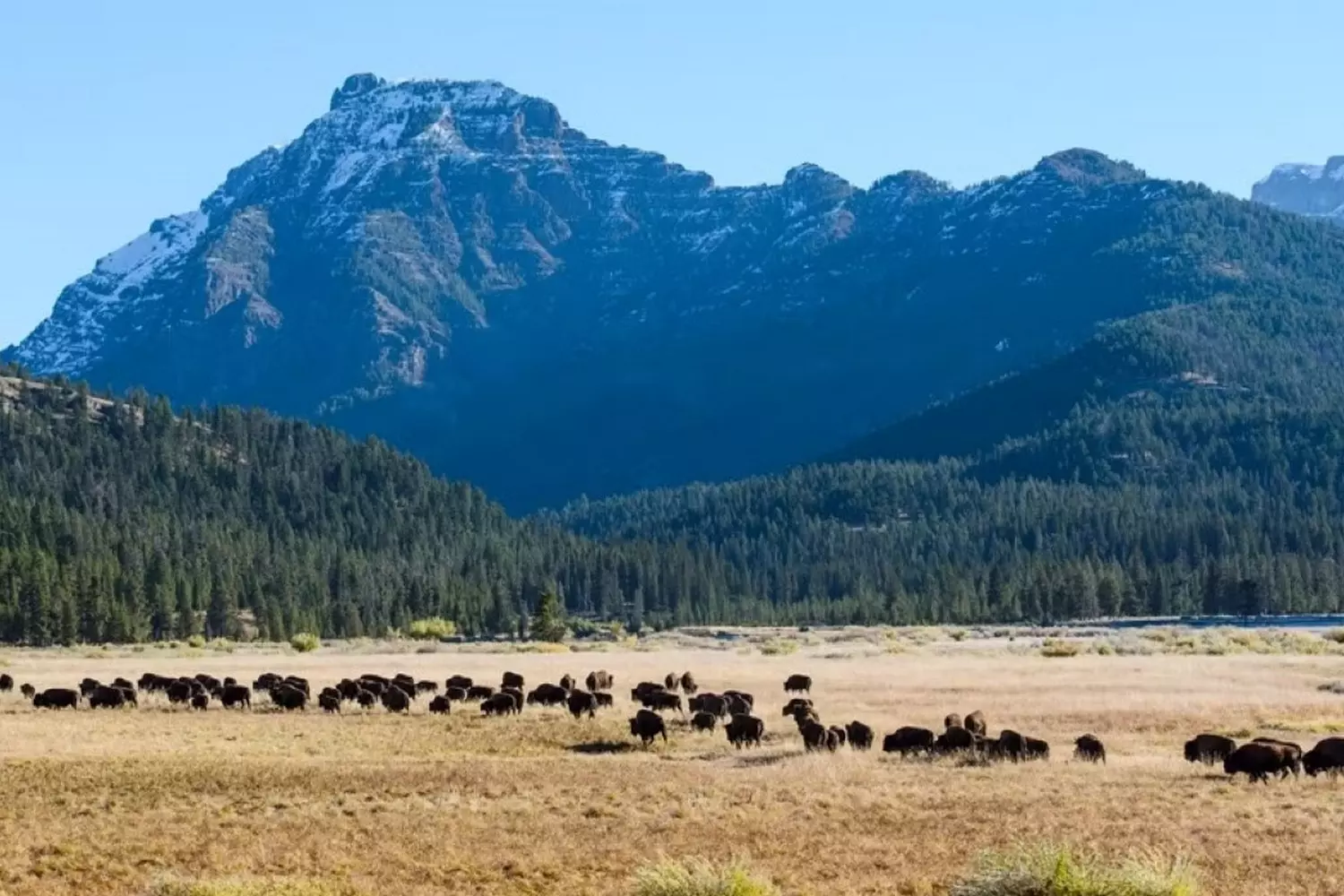
ChatGPT сказал: Basalt Boil: Norris Geothermal Area — The Heart of Yellowstone’s Volcanic Energy
If you want to witness the true power and unpredictability of nature, the geothermal area of Norris is the place that will amaze you. It is the oldest and hottest geothermal region in Yellowstone National Park, where the earth literally breathes and bubbles beneath your feet. Here, geysers don’t just erupt—they hiss, roar, and release plumes of steam with the distinctive smell of sulfur — a true symphony of elements and sounds that is unforgettable.
- 01. What makes Norris unique?
First and foremost, this place is known for the Steamboat Geyser — the tallest active geyser in the world. During eruptions, Steamboat shoots jets of hot water and steam up to 90 meters high, sometimes even higher! However, these eruptions are irregular — they can happen unexpectedly, and sometimes Steamboat remains silent for months, creating an atmosphere of mystery and anticipation. - 02. Unpredictability and dynamics
The Norris area is one of the most dynamic on the planet. Underground shifts, changes in pressure and temperature constantly transform the landscape. You may come here today and see certain geysers, and a week later — completely different ones. Some hot springs and mud pots may freeze, giving way to new ones, as if the earth is changing its attire. - 03. Why visit Norris?
- Witness the raw power of nature up close
Here, you will feel the earth’s crust bubbling and boiling beneath you, as nature showcases its unpredictable force. - Unique landscapes
Yellow, orange, and red mineral hues, rising steam clouds, and boiling mud create incredible scenes, as if taken from a fantastic postcard. - Educational trail
Visitors can explore well-maintained wooden boardwalks and trails with informational signs explaining geological processes and the history of research.
- 04. Traveler tips
- Dress for the weather and prepare for sulfur smells
They can be quite strong but quickly dissipate in the fresh air. - Follow signs and stay on the paths
The ground here is fragile and dangerous, with hot springs and brittle crusts underneath. - Take your time
Norris is a place for observation and reflection, where you want to linger to feel the planet’s energy.
The Norris geothermal area is a window into the hot heart of the Earth, bursting with endless fountains of energy and life. For those who appreciate nature’s power and crave genuine experiences, it’s a must-visit spot on any Yellowstone itinerary.
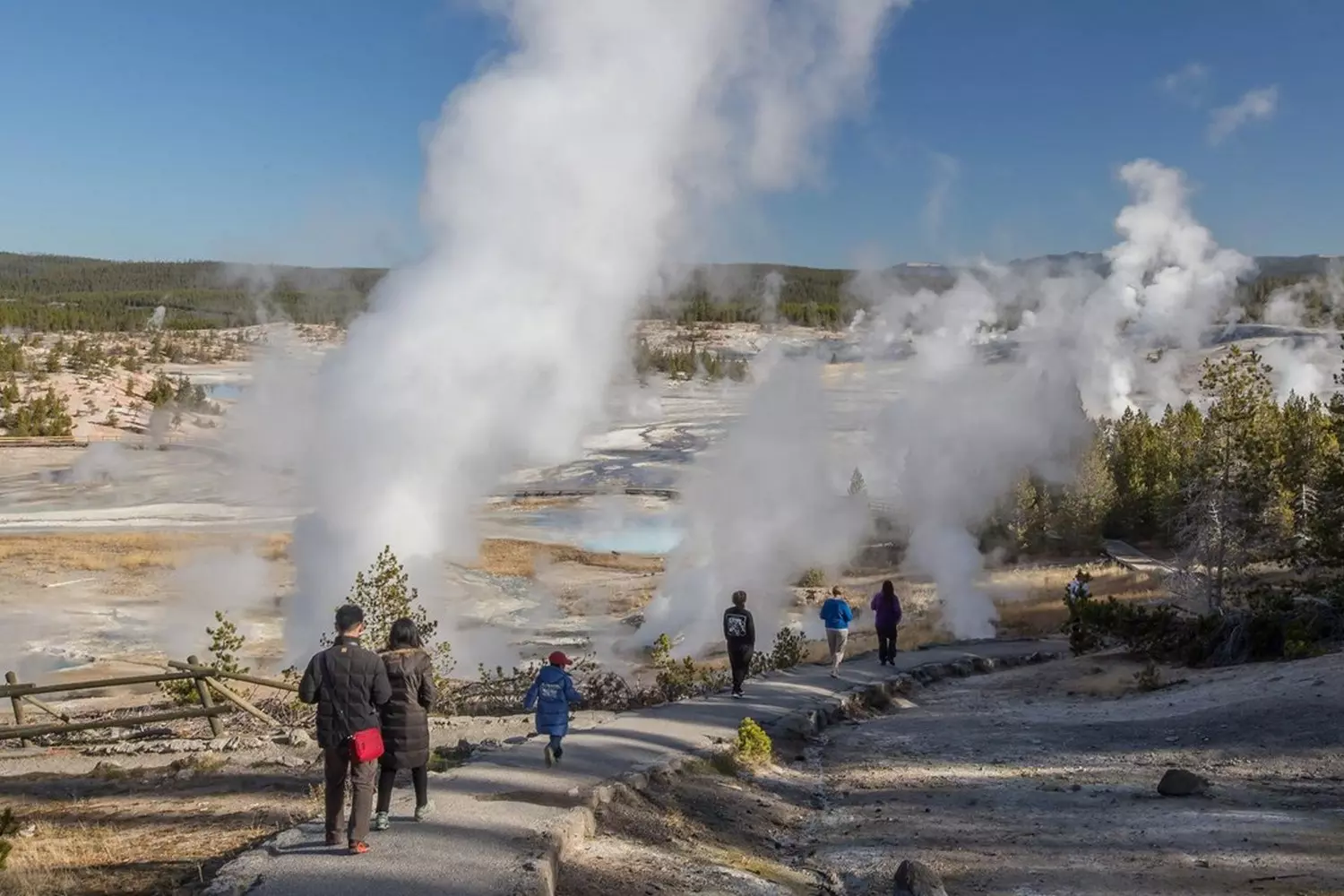
Hidden Gems of Yellowstone: Beehive Geyser and Morning Glory Pool
Yellowstone is not only home to the legendary Old Faithful and Grand Prismatic Spring but also to many lesser-known yet equally stunning natural spots. For those seeking solitude and wanting to enjoy the park’s beauty away from the tourist crowds, there are special hidden gems. Among them are Beehive Geyser and Morning Glory Pool — places where you can truly feel the magic of nature.
- 01. Beehive Geyser — a natural fountain shaped like a beehive
This geyser got its name because its source resembles a beehive. It shoots a jet of hot water over 60 meters high — almost as impressive as the famous Old Faithful. But unlike Old Faithful, Beehive is much less crowded, creating a special sense of closeness with nature.
The geyser erupts irregularly, so its appearance is a kind of natural surprise show. Powerful bursts and clouds of steam make for a rare and thrilling spectacle. The walk to Beehive follows an easy, well-maintained trail that lets you enjoy the view and explore other geothermal features along the way. - 02. Morning Glory Pool — a lake with mystical hues
This small hot spring lake amazes with its rich blue and green shades that change depending on the angle of light and water temperature. The reflections and water’s clarity create the effect of diving into a bottomless blue abyss.
Its name — “Morning Glory” — is no coincidence. Early in the morning, when the first rays of sun dance on the surface, the pool shimmers with bright colors, captivating and calming visitors. - 03. Why visit these places?
- Fewer tourists
Solitude and the chance to peacefully enjoy nature without noise and bustle. - Great conditions for photographers
Beautiful angles, clear water, and lack of crowds make these spots perfect for photos. - Easy and accessible trails
The walks suit everyone, including families with children and those who prefer a leisurely pace. - Immersion in the pristine atmosphere
Here, you especially feel the living breath of the planet.
These hidden corners of Yellowstone are like quiet oases amid amazing natural wonders, where everyone can discover new facets of the park. If you want to be alone with nature and uncover something special, be sure to include Beehive Geyser and Morning Glory Pool in your itinerary.
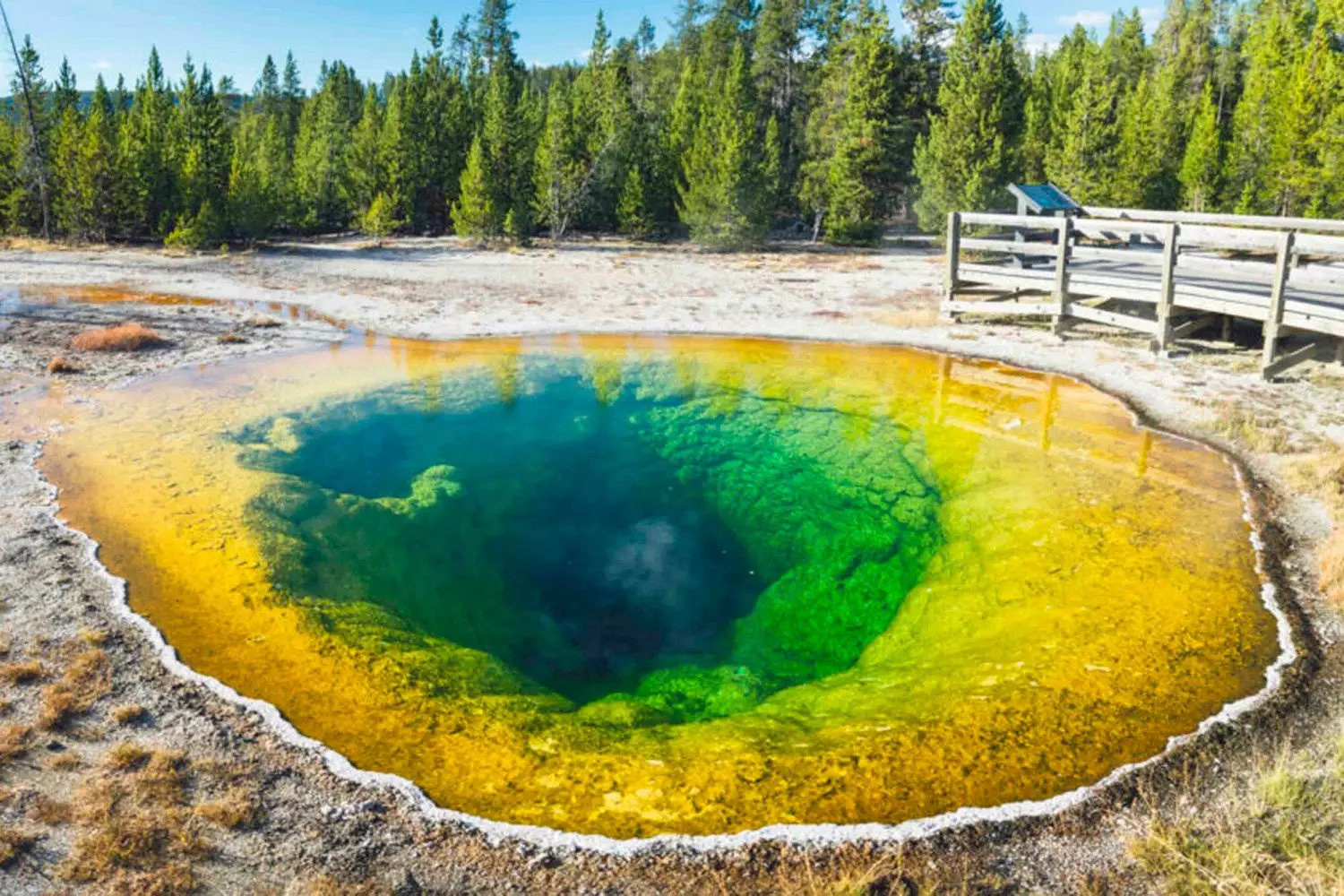
In Nature’s Footsteps: Hiking to Pine Creek Falls and the Summit of Elephant Back Trail
If you want to combine active recreation with magnificent natural views, this route is a true gift. The trail to Pine Creek Falls and the summit of Elephant Back Trail is the perfect choice for those who enjoy moderate hikes, preferring a leisurely exploration of nature with stunning panoramas.
- 01. Impressions from the Pine Creek Falls trail
The route begins deep within a pine forest, where tall firs and pines seem to frame the path with a soft green canopy. The coolness, scent of conifers, and birdsong create an atmosphere of complete immersion in Yellowstone’s wild world. The walk traverses varied terrain but without steep climbs, making it accessible for travelers of different fitness levels.
At the endpoint is Pine Creek Falls. Tall and powerful, it thunderously drops water down the rocks, spraying cool freshness and creating rainbows on sunny days. It’s a perfect spot to rest, take photos, and simply admire the beauty. - 02. Elephant Back Trail summit — a reward for your efforts
After resting at the falls, the climb begins along the Elephant Back Trail — a moderately steep ascent leading to the hilltop. The name “Elephant Back” comes from the shape of the terrain, which resembles an elephant’s back. From here, one of Yellowstone’s most breathtaking panoramas unfolds: Yellowstone Lake spreads out in all its glory, surrounded by forests and mountains.
It’s especially striking to see how the colors of nature change throughout the day — from morning mists to the golden glow of sunset. - 03. Who is this route for?
- Moderate activity lovers
Will appreciate the comfortable terrain and trail length. - Landscape photographers
Will find many unique angles here — from forest trails to wide views from the summit. - Families with children
The route is safe and varied enough to engage even the youngest travelers.
This route is an excellent way to spend a day outdoors, feel the living nature of Yellowstone, and recharge with the energy of mountains and forests. Whether you’re an experienced hiker or simply enjoy leisurely walks, Pine Creek Falls and Elephant Back Trail will offer you unforgettable impressions and inspiration.
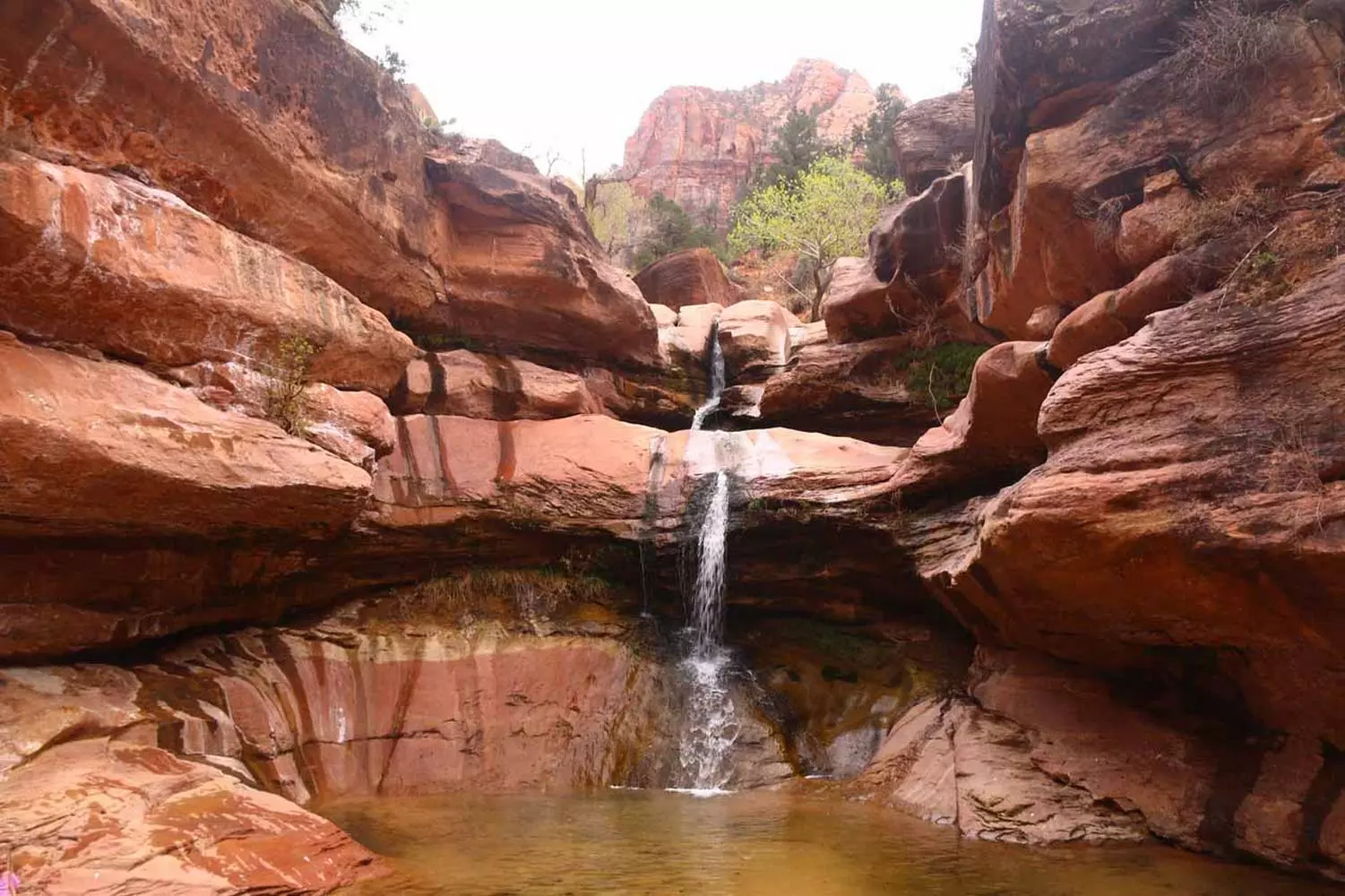
Secret Waterfalls and Hot Rivers of Western Yellowstone: Nature for the Select Few
When you think of Yellowstone, famous geysers and massive canyons usually come to mind. But on the park’s western side, there are lesser-known yet equally captivating natural spots — secluded waterfalls and warm rivers that offer a unique experience of closeness with wild nature.
- 01. What are hot rivers?
Unlike ordinary rivers, some waters on Yellowstone’s west side are warmed by underground thermal springs. This means that in certain spots the water temperature is comfortably warm, and sometimes even hot — a true natural outdoor spa. These rivers not only surprise with their warmth but also delight with the beauty of the surrounding landscape: clear, transparent water flowing among pines, mountains, and rocks, creating a tranquil atmosphere. - 02. Secluded waterfalls — away from crowds and noise
There are several picturesque waterfalls on the park’s west side that aren’t part of standard tourist routes. These waterfalls are much quieter and more peaceful than their famous counterparts, offering a real sense of discovery. The sound of falling water, fresh air, and near absence of people create perfect conditions for relaxation and contemplation. - 03. Important tips for travelers
- Before you take a dip, be sure to check where swimming is allowed and safe
Some hot springs are too hot or contain dangerous minerals, so swimming there is strictly prohibited. Information is available at visitor centers or on official park websites. - Dress comfortably and bring a change of clothes
It’s pleasant to change into dry clothes after bathing in warm water, especially if you plan to continue hiking. - This route is a great alternative to crowded and noisy tourist trails
Here, you’ll find fewer people, more silence, and opportunities to enjoy nature without the hustle. - Remember safety rules and nature conservation
Don’t leave trash, don’t damage vegetation, and respect park boundaries.
- 04. When is the best time to visit?
The best time to visit the western waterfalls and hot rivers is late spring, summer, and early autumn. During these months, the weather is milder, and the water temperature in thermal springs is most comfortable. In winter, access to these areas is often limited due to snow and ice.
Western Yellowstone is a quiet corner of wild nature that will delight those seeking harmony and new experiences off the beaten path. Here you’ll find natural “jacuzzis” and waterfalls hiding their secrets from noisy crowds — a perfect place to retreat and enjoy the true beauty of wild America.
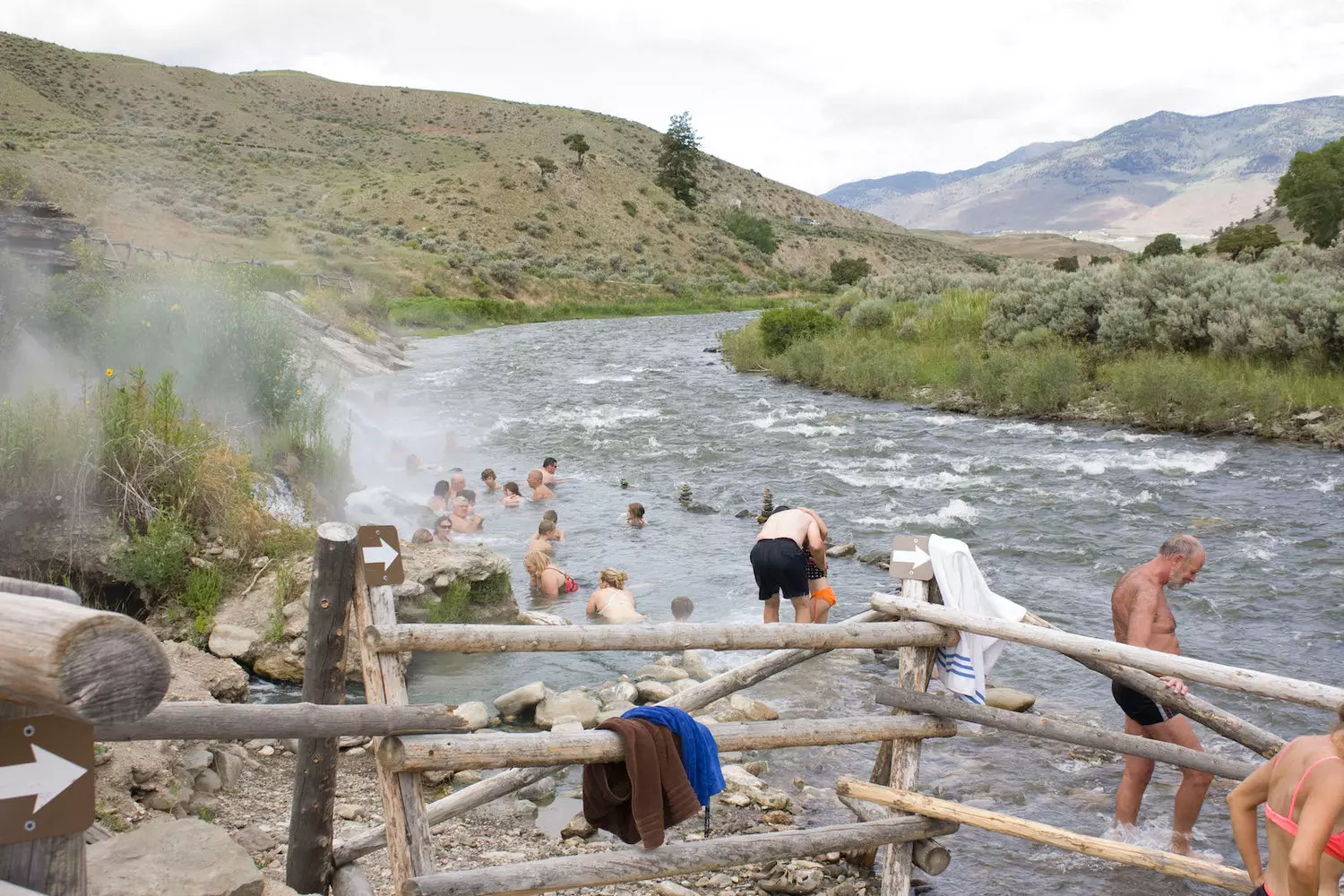
What Else to See in Yellowstone: Hidden Treasures and Unforgettable Routes
Yellowstone is not only famous for its geysers and canyons. The park is vast and rich with amazing spots that every traveler should explore. Beyond the main attractions, there are many unique places where nature reveals its secrets in the most unexpected ways.
- 01. Fountain Paint Pot
This small geothermal area is famous for its colorful mud pots that bubble and boil right on the ground. Here you can see mud volcanoes "cooking" a rich mineral mixture and beautiful patches of colorful deposits. The trail around the area is short and easy — perfect for walks with children and those wanting to discover a less known but impressive part of Yellowstone. - 02. The Volcanic Caldera
The park itself is a giant supervolcano caldera, and you can observe its manifestations in the form of hot springs, mud pots, and cracks in the earth. Visiting geothermal zones such as Norris Geyser Basin and Mud Volcano lets you feel the power of Earth's underground forces. Don’t forget to check the information boards to understand the processes happening beneath your feet. - 03. Bison Range
Yellowstone is home to thousands of bison, and although they are often seen in Lamar Valley, specially designated reserves and trails allow you to get closer to these majestic animals. Remember: these are wild creatures, so always observe them from a safe distance. - 04. Upper Mammoth Hot Springs Terraces
If you’ve already visited the lower terraces, be sure to head higher — there you will find even more mesmerizing views and rare geothermal formations. The upper terraces are less crowded and very scenic, perfect for those seeking solitude. - 05. Swan Lake
A small but very picturesque lake located near popular trails. It’s ideal for picnics and relaxing in nature. You can often see swans and other waterfowl here, creating a special atmosphere of tranquility. - 06. Trail of the Cedars
This easy walking trail runs through an ancient cedar forest where trees reach impressive sizes. The path is equipped with boardwalks and signs, making it accessible even for families with children and elderly visitors. Walking here allows you to enjoy the silence and beauty of centuries-old forests. - 07. Hayden Valley — Wildlife Valley
One of the best places to observe wildlife. Here you can often see deer, bison, bears, and numerous birds. The valley is surrounded by picturesque mountains and is covered by a light mist in the early morning, creating a magical atmosphere.
Yellowstone is a living, ever-changing ecosystem. Every corner of the park tells its own unique story. Exploring the lesser-known attractions, you will not just see nature but feel its spirit, learn its secrets, and gain unforgettable experiences that will stay with you for a lifetime.
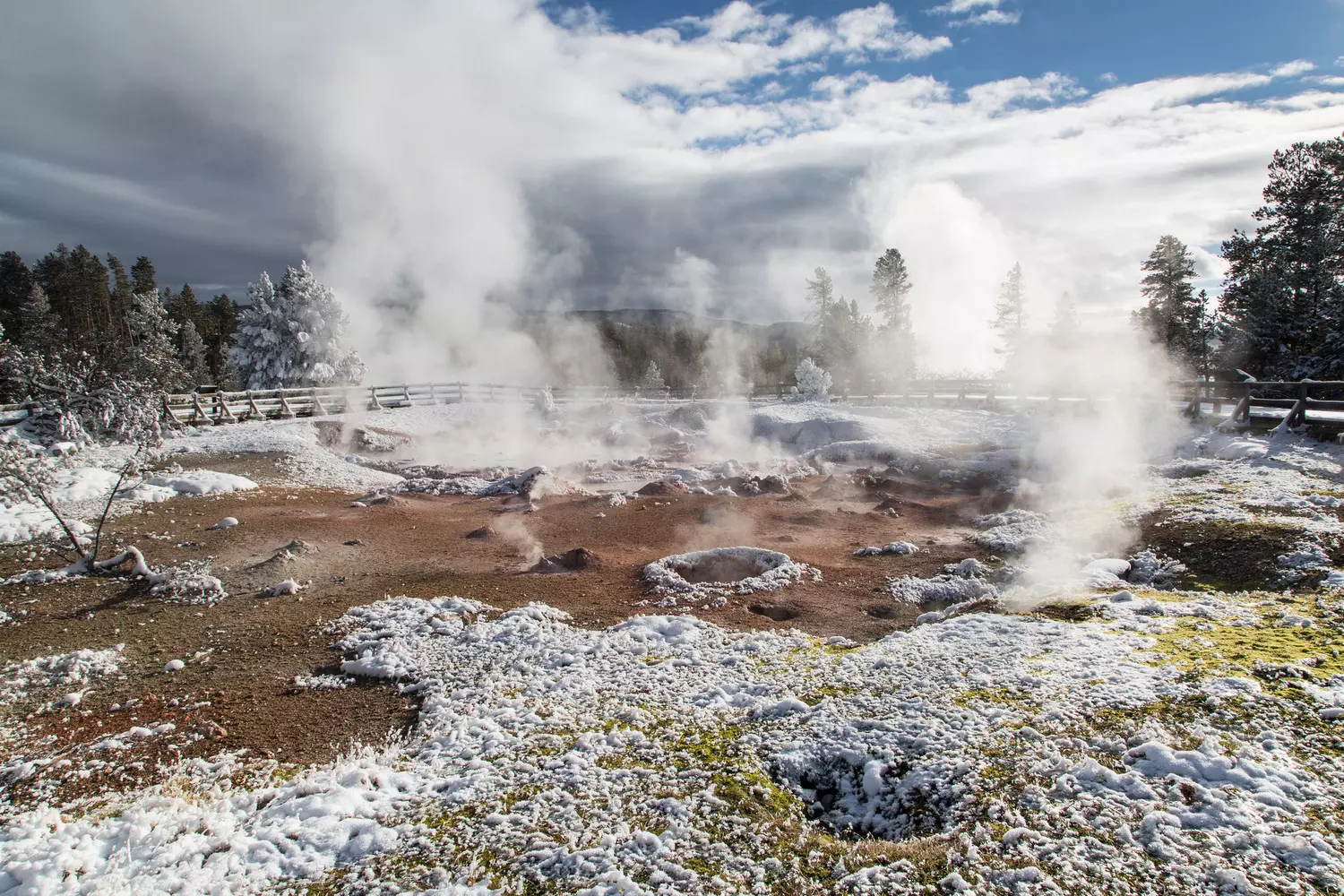
How to Plan Your Trip: Routes for One Day, a Weekend, and a Vacation
Yellowstone is a vast and incredibly diverse national park that’s hard to see all at once. But don’t worry: no matter how much time you have, you can plan your trip to get the most impressions and truly feel the magic of this amazing natural wonder. Let’s look at how to best organize your visit depending on its length.
- 01. If you have just one day: a concentrate of the brightest impressions
In one day, it’s best to focus on the places that most vividly and fully represent Yellowstone’s uniqueness.
- Old Faithful
The park’s symbol and its most famous geyser. Its eruption is almost guaranteed and a thrilling sight that sets the tone for the whole trip. The infrastructure around the geyser is convenient and allows quick access to other thermal features. - Grand Prismatic Spring
The largest hot spring in the USA with bright, paint-like colors created by thermophilic bacteria. Perfect for striking photos and to get acquainted with the park’s unique geothermal beauty. - Yellowstone Canyon
The “Grand Canyon of the North” with stunning views, waterfalls, and rich wildlife. Here you can feel the grandeur of nature and enjoy scenic viewpoints.
This basic route allows you to gain an unforgettable experience in one day, see the most iconic spots, and take beautiful photos.
- 02. If you have 2–3 days: broaden your horizons and deepen your impressions
Add a few more places to the basic route that are no less interesting and allow you to immerse yourself in wild nature and geological wonders.
- Mammoth Hot Springs
Amazing limestone terraces that look like snowy frozen waves. A unique geothermal site that perfectly complements geysers and hot springs. - Lamar Valley
The ideal place for wildlife watching. Here you have a good chance to see bison, bears, wolves, and other park inhabitants. - Stay near Yellowstone Lake
Camping or a hotel near the lake will give you a chance to wake up to birdsong and enjoy stunning sunrise and sunset views.
This plan lets you take your time, carefully explore the park’s nature, and have more rest and reflection time.
- 03. If you spend a whole week in the park: full immersion into Yellowstone’s world
A week is ideal for those who want to see Yellowstone in all its beauty and diversity.
- You’ll be able to explore all 10 key locations, including some lesser-known spots: Beehive Geyser, Norris Geyser Basin, western hot rivers, and hidden waterfalls.
- Include hikes of various difficulty — from easy walks to Pine Creek Falls to more challenging climbs on Elephant Back Trail.
- Organize wildlife safaris with early departures to Lamar Valley and Hayden Valley to see animals in their natural habitat.
- Try fishing in the park’s lakes and rivers — a great way to relax and truly connect with the wild nature.
- And of course, enjoy leisurely evenings by the campfire or in comfortable camping and hotel conditions, reflecting on each new day of adventure.
Yellowstone is a park impossible to take in all at once, but that’s exactly what makes it so captivating. Even a short visit will give you memories for a lifetime, while a longer stay lets you see and feel the full variety and depth of its natural wonders. Travel comfortably, plan wisely — and Yellowstone will reveal its most beautiful and amazing sides to you!
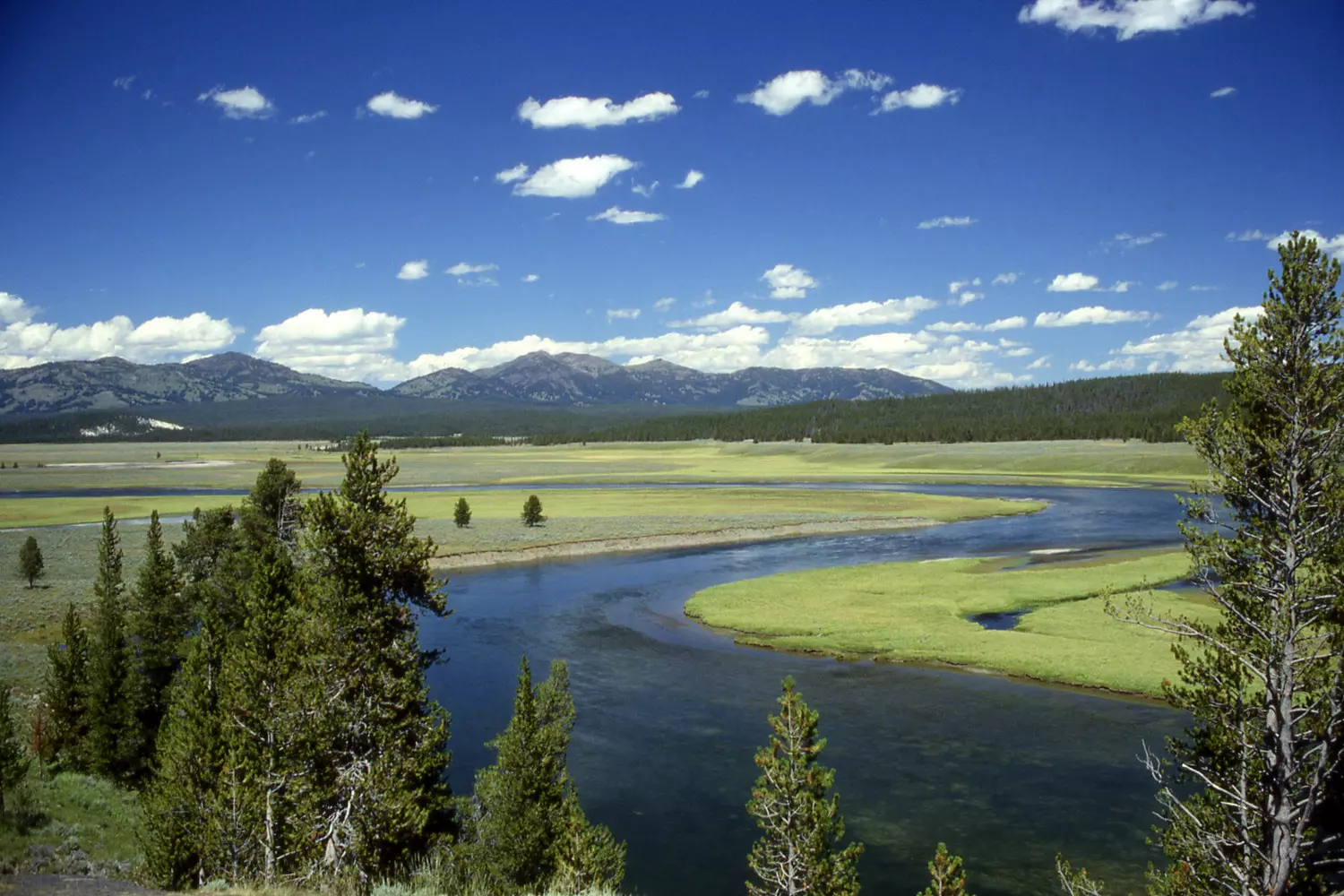
Useful Tips for Visiting Yellowstone: How to Make Your Trip Comfortable and Safe
Yellowstone is an incredible place filled with beauty and unique nature, but to ensure your trip goes smoothly and leaves only positive impressions, it’s important to prepare in advance. This section offers practical tips to help you avoid common mistakes and make your stay as comfortable and safe as possible.
- 01. Plan your route ahead of time
The park is huge — its area exceeds 9,000 square kilometers. Your route choice depends on how much time you plan to spend here. Be sure to study the map and mark key spots: geysers, canyons, lakes, hiking trails. This will help you manage your time efficiently and avoid unnecessary travel. - 02. Dress in layers and according to the weather
Weather in Yellowstone can change very quickly — it might be chilly in the morning and hot during the day. Bring several layers of clothing: thermal underwear, a fleece jacket, a windbreaker, and a waterproof coat. Comfortable shoes with good support and waterproofing will protect your feet on rocky and wet trails. - 03. Protect yourself from the sun and insects
High altitude and open spaces in the park mean strong sun exposure. Use sunscreen with a high SPF, wear a hat and sunglasses. In summer, there are many mosquitoes and ticks — repellents will help avoid unpleasant bites. - 04. Always carry water and food
There are not many cafes or stores inside the park, so bring enough water (at least 2 liters per person per day) and snacks. Energy bars, nuts, and fruits will help keep your strength during walks. - 05. Follow safety rules when encountering wildlife
Yellowstone is home to many wild animals. Never approach them closely or try to feed them. Use binoculars for observation and keep a distance of at least 100 meters from bears and wolves, and at least 25 meters from other animals. If you encounter a bear, follow the park’s instructions. - 06. Stay only on designated trails and paths
To preserve the fragile ecosystem and ensure your safety, do not leave marked routes and boardwalks. Many geothermal features have a thin crust over boiling water — a fall could cause serious injuries. - 07. Book accommodation in advance
Campgrounds and hotels in Yellowstone often fill up well before the season starts. If you plan to visit in summer or during holidays, book your accommodation several months ahead to avoid placement issues. - 08. Prepare your equipment
Charge cameras, phones, and other devices every evening. Bring an extra battery or portable charger, especially if you plan long hikes and filming. - 09. Respect nature and other tourists
Keep quiet, don’t leave trash, don’t break plants or disturb animals. Remember that Yellowstone is home to many living creatures, and it’s your responsibility to preserve its beauty for future generations.
Good preparation is the key to a successful trip. By following these tips, you will keep yourself safe and make your stay in Yellowstone as comfortable, interesting, and memorable as possible. May your journey be filled only with pleasant discoveries and vivid impressions!
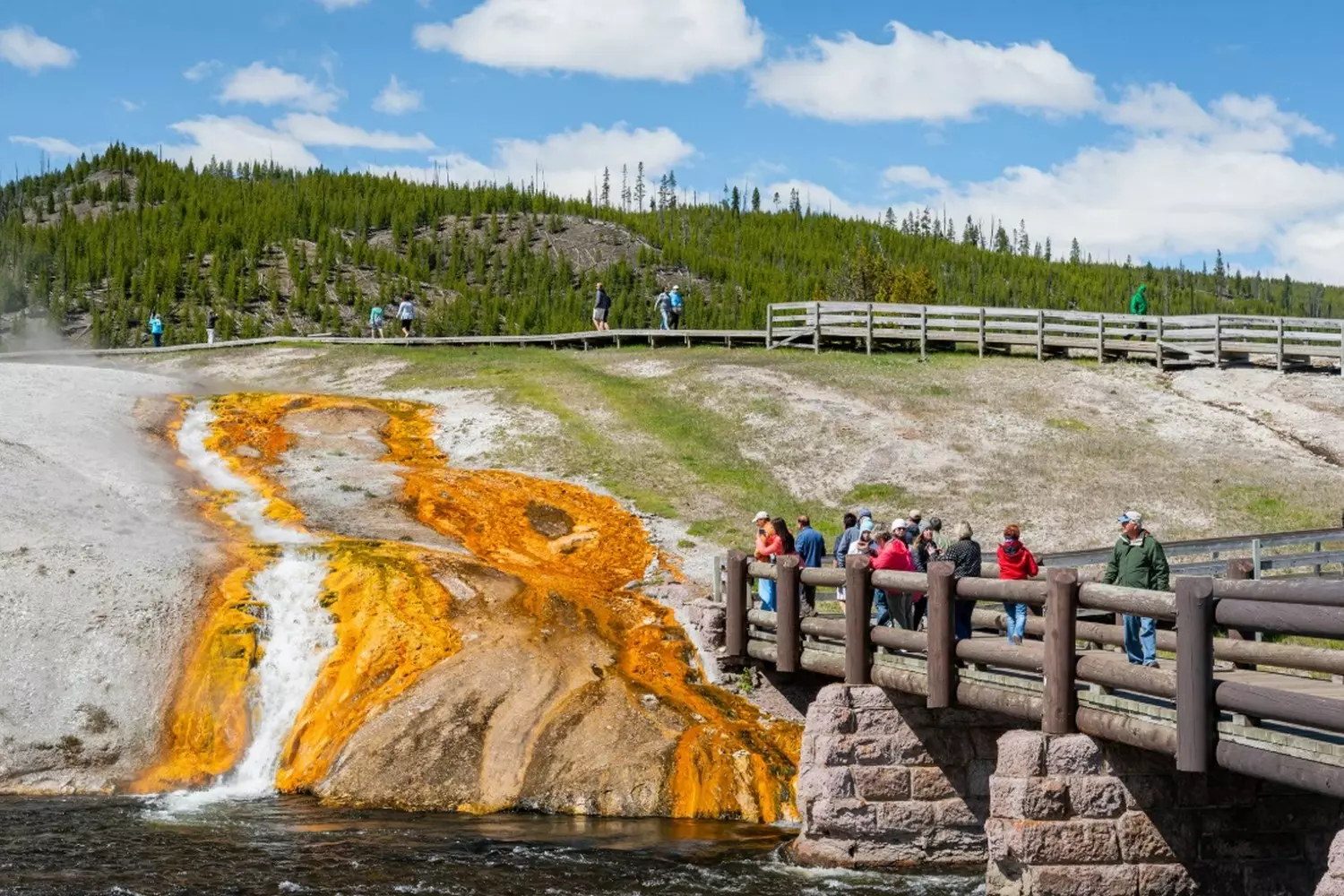
With American Butler — Deeper, More Comfortable, and Safer
Yellowstone is not just a beautiful landscape — it’s an experience that stays with you forever. Here, you feel the breath of the Earth, witness the planet’s formation, and sense your part in something vast and ancient. When planning your trip, it’s important not only to choose the places to visit but also to properly organize everything: logistics, accommodation, routes, safety, and guides.
American Butler offers personalized and family tours to Yellowstone tailored to all your wishes. Professional guides, comfortable transfers, unique locations not found in guidebooks — everything so you feel that this journey was made just for you.
It’s time to take a step toward a true adventure.














